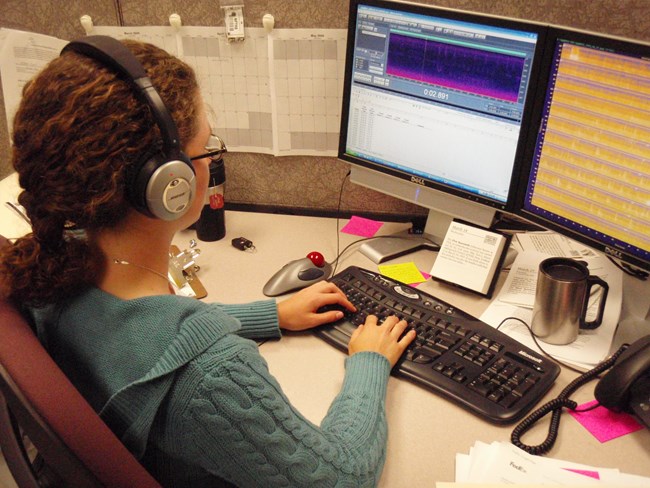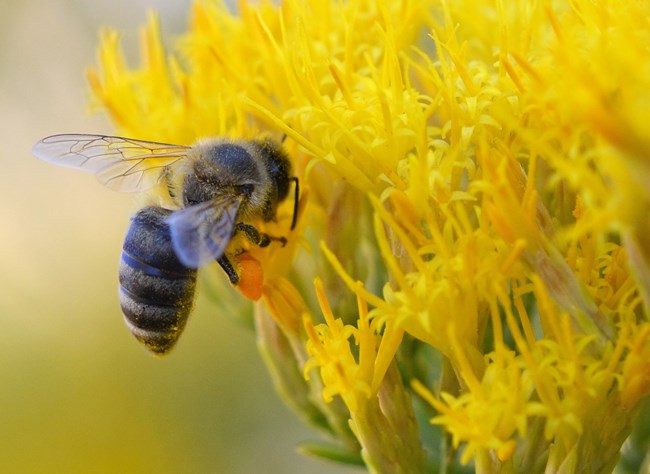
NPS
National Park Service scientists record and analyze sounds in national parks to inform and improve management of units across the country. The Natural Sounds and Night Skies Division collects data using systems that record audio as mp3 files and sound pressure levels in decibels. These are designed to replicate the hearing experience of a person on the ground.
Sounds gathered are analyzed at the Protected Areas Research Collaborative (PARC) Listening Lab, a research collaborative between the NPS and the Department of Recreation, Park, and Tourism Management at Pennsylvania State University. Technicians study these sounds using spectrograms — images that display the sounds according to loudness, frequency, and time of occurrence.The audio recordings help technicians identify sounds' source of origin, such as wildlife, weather, park visitors, and park operations. Visit Measuring Sound to learn more about how the NPS measures and analyzes sounds. This list of available reports summarizes sound measurements taken in national parks.
The following sound clips are selections of natural and human-made sounds recorded in national parks. (Alphabetical order: Amphibians, Birds, Cultural-Historical, Geological, Hydrological, Insects, Machines, Mammals, Meteorological, Reptiles.) The files are in the public domain and may be downloaded. Enjoy, and please give the appropriate credit.
Peruse these additional sound libraries:
Sounds gathered are analyzed at the Protected Areas Research Collaborative (PARC) Listening Lab, a research collaborative between the NPS and the Department of Recreation, Park, and Tourism Management at Pennsylvania State University. Technicians study these sounds using spectrograms — images that display the sounds according to loudness, frequency, and time of occurrence.The audio recordings help technicians identify sounds' source of origin, such as wildlife, weather, park visitors, and park operations. Visit Measuring Sound to learn more about how the NPS measures and analyzes sounds. This list of available reports summarizes sound measurements taken in national parks.
The following sound clips are selections of natural and human-made sounds recorded in national parks. (Alphabetical order: Amphibians, Birds, Cultural-Historical, Geological, Hydrological, Insects, Machines, Mammals, Meteorological, Reptiles.) The files are in the public domain and may be downloaded. Enjoy, and please give the appropriate credit.
Peruse these additional sound libraries:
- Sounds of the Parks by the Colorado State University Listening Lab.
- Yellowstone National Park Sound Library and Yellowstone Audio postcards — short stories about soundscapes unique to Yellowstone's ecology.
- Rocky Mountain National Park Sound Library
- Voices of Glacier Bay Soundscape Project
Amphibians

NPS
Birds

NPS
- Alder Flycatcher
- American Robin
- Anhinga
- Bald Eagle
- Canada Geese
- Clark's Nutcracker
- Common Poorwill
- Common Raven
- Dawn Chorus
- Hermit Thrush
- Killdeer
- Northern Flicker
- Olive-sided Flycatcher
- Osprey
- Ptarmigan
- Raven and Peregrine Falcon
- Red-breasted Nuthatch
- Sandhill Crane
- Spotted Owl
- Stellar's Jay
- 'Ua'u (Hawaiian Petrel)
- Western Gull
- White-crowned Sparrow
- Yellow-rumped Warbler
Cultural-Historical

NPS
Geological

NPS
Hydrological
Insects

NPS
Machines

NPS
Mammals

NPS
Meteorological
Reptiles

NPS / Emma Brown
Last updated: September 3, 2025


